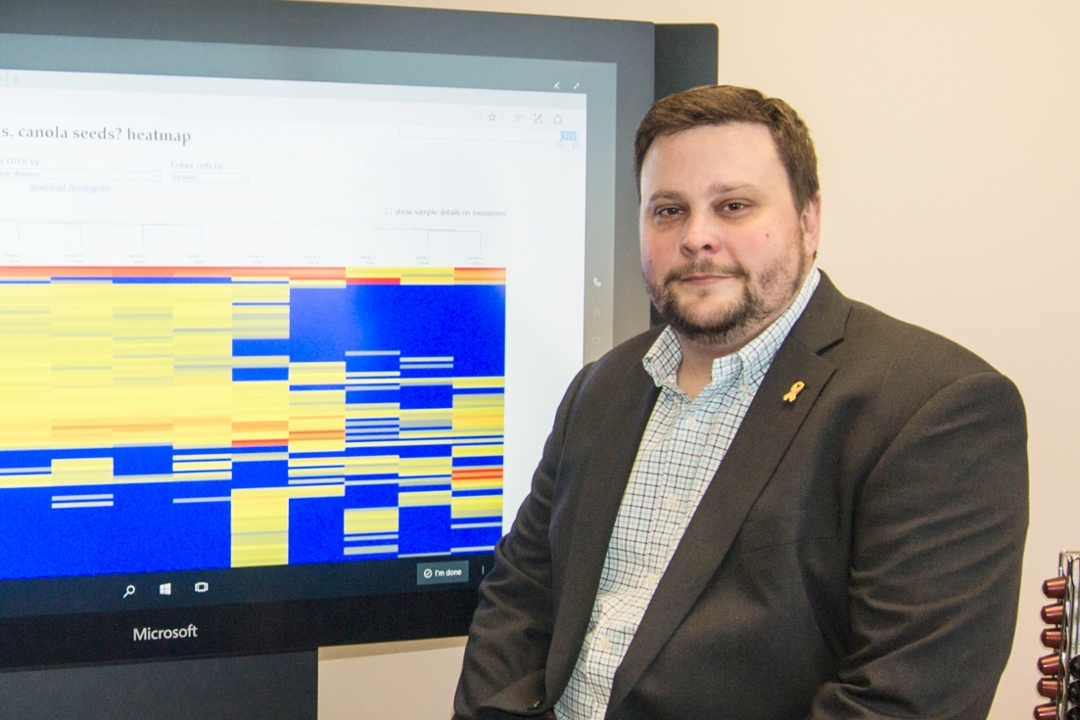
A trip into the unknown
Matthew Links is one of a new breed of scientists exploring the strange world of microbes.
By Glenn CheaterEver since the invention of the microscope, we’ve known they’re out there—congregating in the millions and billions on (or in) just about anything on the planet, including us.
But despite intense scrutiny, microbes—bacteria, fungi, viruses, and their fellow microscopic critters—remain one of science’s great mysteries.
Take, for example, the simple task of eating. We know microbes in our digestive tracts break down food into nutrients that our bodies can use. But even the most basic questions—How many participate in that everyday act? Which does what?—are, as yet, largely unanswerable.
“Life is way more complicated than we give it credit for,” says Matthew Links, who became an assistant professor of animal science at the University of Saskatchewan in November. “There are a lot of bugs. Some estimate there are 10 times more microbial cells in or on you than constitute you. People joke about whether you are the entity or whether microbes are the entity and you’re their slave.”
Regardless, we need each other. While there are certainly a lot of bad bacteria, fungi, and viruses, there are many good ones, too. Some play a role in making us healthy by, for example, boosting our immune system or combating pathogens. But before we can figure out which ones do what and how, we need to get a handle on how many.
“Most of the microbes we know are the ones we can grow on petri dishes,” says Links. “But when you think about the number of possible conditions that exist on our body or in a stomach or in a rumen, there is huge diversity. And we’re blind in even being able to know who is there.”
It’s a challenge that requires a new breed of scientist—and that’s exactly what Links is.
The 39-year-old developed his twin-track passion for computer programming and life sciences (specifically genomics) in his teens and is now an expert in bioinformatics (a mash-up that also includes statistics, mathematics, and engineering). Those skills have been increasingly in demand since the sequencing of the human genome in 2002 (“Our equivalent of the moon landing”), but his hybrid science is still something quite new and different.
“The department is really being visionary in saying, ‘We need to go in this direction, even though we don’t entirely know yet where it’s going to lead us,” he says.
And it truly will be a trip into the unknown. Scientists like Links are exploring collections of hundreds or thousands of different microbes called microbiomes. Their populations and interactions are in constant flux, and even the number of species is a big question mark because of the petri dish problem—if you can’t culture a species in the lab, how do you study it?
Well, you can track it by using DNA biomarkers, which act as a sort of genetic radio collar.
“So even if we don’t know what to call it yet, we can track its abundance and we can see if the population goes up or down when we do something to the system,” says Links. “Is it susceptible to this antibiotic? Does it get knocked back or does that knock down its enemy and increase its abundance?”
But once you’ve tagged all these different types of microbes, how do you make sense of what they’re doing?
“My work is different because instead of studying one organism at a time, it’s focused on what organisms matter most. We’re really letting the data speak first.”
In some ways, that’s the opposite of a traditional investigation.
“We don’t want to come to an experiment with a pre-conceived notion of what bugs are bad and which ones are good, but rather let the data tell us which ones are behaving badly,” says Links. “Instead of saying, ‘I’m going to go and only test if this is a probiotic,’ we’ve realized there’s a much more fluid nature to these microbes. They do lots of things—some of which are good for us and some of which could be bad for us if they’re in the wrong place.”
It’s a sensible enough view, until you think how much data there is. Although most genomes of bacteria consist of a single chromosome, each one has several million base pairs governing many, many different biological functions. And again, there are huge numbers in every microbiome.
It’s an unimaginably complex task but one with great promise.
The ability to identify microbes that help animals grow faster or shake off bugs that sicken their herd mates would be a game-changer. ‘Metagenomics’ may be our best bet in that search, but probing big data requires big teams of researchers. Links is also at the forefront of that effort. He’s led the development of a software program that “brings the concept of FaceTime to the analysis of data” and allows anyone with an interest in the field to participate in group collaboration.
“It’s always seemed normal to me to have a computer geek, a math nerd, a plant breeder, a statistician, and even an English major all in the same room just talking and collaborating,” he says. “This program re-creates that using technology, so you can have all types of people in the same virtual room.”
It’s a new type of science and a new way of working together. But it may finally allow researchers to answer some very old questions about the fundamentals of life.

